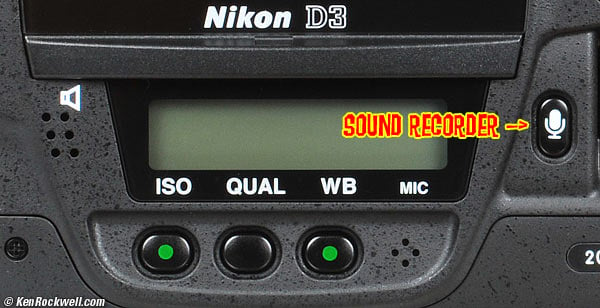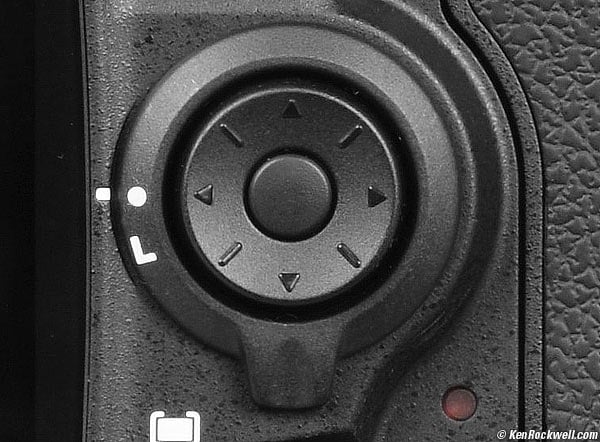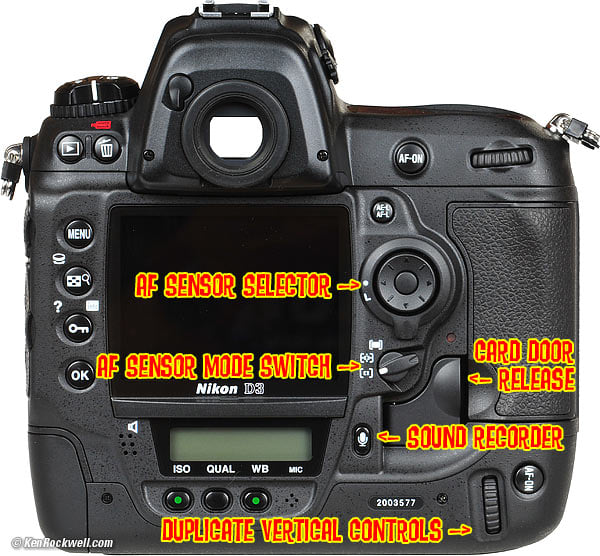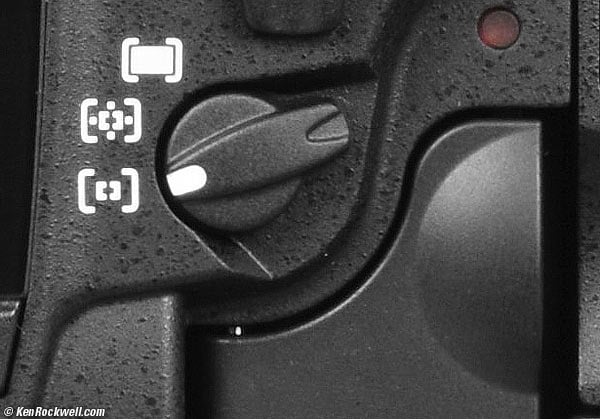Nikon
D3 User's Guide:
Rear Controls
© 2008 KenRockwell.com. All rights reserved.

Nikon D3 rear.
August 2008 Top of D3 Users Guide D3 Review More Nikon Reviews
Want free live phone support? In the USA, call (800) NIKON-UX, 24 hours a day, 365 days a year.
From left to right, top to bottom:
Play [>] Button top
Press it to see your pictures. Press again to turn them off.
There are a lot of trick play modes, like zooming all the way in with the center control button and being able to scroll around with the dials.
My favorites are explained under the settings for the rear thumbswitch and the Command Dials.
Trash (also doubles as one of the two FORMAT buttons) top
With an image on the LCD, press once. You'll get an "Are you sure?" message. Press again and the shot's gone. The D3 ignores this button if it's not playing back.
Hold this along with its brother (the MODE button) to format a memory card as I explained on the previous page.
MENU top
This gets you inside your D3.
I'll cover what you can screw up with this in the 11 long pages that follow.
Checkerboard (magnifier) top
Playback Only: Hold it and spin the rear dial to zoom, or to call up a page of 4 or 9 teeny images.
Trick: When you have 4 or 9 images up, spin the front knob to flip more quickly between rows of images, presuming you've turned this on in custom setting f7.
?/Key/INFO top
While in Menus: "?." Press for more information about whatever you're setting, if you see a gray "?" on the lower left of the color LCD. If no gray "?," then there is no help available.
While in Playback: "Key." It protects (locks) the image from erasure.
Warning 1.): It marks the file so well that it won't empty out of my trash on my computer unless I go in and remark the file on my computer first!
Warning 2.): These images are erased from your memory card when you format anyway. Now you see why I don't use the lock feature.
While Shooting: "INFO." It calls up a display of just about everything you might want to know on the huge rear color LCD. I find this far more useful than the vestigial top or rear LCDs.
OK top
Only while in menus: Takes action on what you've set.
Finder Blind (near eyepiece) top
The finder blind is the little lever just above and to the left of the eyepiece.
Flick it left to close a shutter to prevent light from leaking into the finder.
You'll want to do this if you're shooting without your eye on the finder. If you take your eye away, light could get in this back door and cause the meter to underexpose your pictures.
If you close it, you won't be able to see through the finder until you flick it to the right to open it.
ISO, QUAL, WB and Sound Recorder
Hold any of these and spin the control knobs to adjust. While playing, the Sound Recorder button records sound.

Rear center bottom controls: Nikon D3.
ISO • (also has a green dot) top
ISO is pronounced Eye-Ess-Oh, not "eyeso."
Hold this and spin the rear dial to change ISO. Default is 1/3 stop steps. I prefer to change ISO in more meaningful full stops as you can set in a menu here.
Firmware Flaw: ISO goes from 100 to 25,600. Above ISO 6,400 Nikon uses bizarre terminology to scare amateurs away from setting these ISOs because these same amateurs would clog up Nikon's (800) NIKON-UX support lines complaining about grain. Nikon calls ISO 12,800 "H+1.0," and ISO 25,600 "H+2.0." Likewise, ISO 100 is called "L-1.0."
Hint: Since ISO is displayed in the finder, you can set this without taking your eye from the finder.
Hint: If you've selected Auto ISO, then you cannot set a manual ISO higher than you allow in Auto ISO. To get weird ISOs like ISO 12,600 (H+1.0), you must turn off Auto ISO.
Green Dot •
The green dot, when held along with the green dot on the WB button, resets most things back to normal.
QUALity top
QUALity sets the file format and compression levels.
Hold it and turn the rear dial to choose the kind of file (JPG, TIFF or raw), and the level of JPG compression. Keep spinning the dial, and you can record raw at the same time as JPG.
Hold and turn the front dial to change JPG and TIF image size in pixels.
I use Large or Medium and JPG BASIC.
The D3 has enough resolution for great 20x30" (50x75cm) prints. Even the Medium setting has plenty of resolution for great 12 x 18" (30x50cm) prints, so I usually shoot in Medium unless I plan to be making huge enlargements.
As I explain on page one, I chose JPG Optimal Quality, and then Basic. This gives me great quality at the smallest possible file size.
Why do I worry about file size? Simple: I shoot a lot, and I bloated files waste time and money in transfer, backup and storage. Try it: shoot the same thing at several settings, and you won't be able to see the difference. See this on my D200.
White Balance (WB) • (also has a green dot) top
This is critical to getting the photos you want right out of your D3.
Spin the rear knob for broad changes. Spin the front knob to fine tune. See my White Balance Examples page and my White Balance page for the specifics of each setting.
Here is a run down of the individual settings from left to right, as shown along the bottom of the top LCD and as set with the rear dial:
Auto (A)
I use this all the time. It makes its best guess for WB. It's usually very good. Indoor tungsten can be too orange unless you have some bright tungsten light also in the image. If you do, it removes the orange and compensates completely. If not, the D3 only partly compensates and you have a nice warm image instead.
Tungsten (hanging light bulb icon that's easy to confuse with the sun)
This makes the picture very blue. Use this only for deliberate freezing Arctic effects, or under conventional tungsten light bulbs.
Fluorescent (glowing tube icon)
Used to make crappy fluorescent light look less crappy. These settings rarely work; use the preset setting below for better results.
Direct Sunlight (smiling sun icon)
Use this outdoors with sun shining directly on the subject.
Flash (lightning bolt icon)
I never use this. It's almost the same as direct sun. I'm told it's really for studio strobes, since the Auto mode compensates magically for flash if you use it on-camera. The reason to use this is if you use a different trim value for your strobes than you do for sunlight. I'll get to trims in a bit.
Cloudy (cloud icon)
Warmer (more orange) than the sunlight position. I use this in shade, too.
Shade (house casting a shadow icon)
Very warm. Adds orange to your photo. Use this for sunset shots, or shots in open shade lit by the sky.
Continuously Variable (K)
This setting lets you choose any amount of blue or orange. Once you select "K" you choose the value, from 2,500 to 10,000, with the front knob while holding WB. The calibrations are abstract in what we scientists call (degrees) Kelvin. More degrees look warmer. There are no rules in real-world photography: use whatever setting looks best to you.
2,500 K is very, very blue. I'll use something around 2,650 K in dim home lighting to get neutral results. 3,200 K is the same as the tungsten setting above. 5,400 K is the same as direct sun above. I'll use something around 4,000 K indoors with a mixture of sun and tungsten light. 10,000 K is very, very orange. The shade setting is similar to 7,500 K, and 10,000 K is the warmest (most orange).
Preset (PRE)
You use this setting with a white or gray card to get perfect color matching. The D3 can recall five settings: just hold "WB" and spin the front know after choosing PRE with the rear knob. You need to use menus, explained later, to save the five settings.
I never use an actual card. I always grab a napkin, t-shirt, back of a menu or other piece of white. Black text makes no difference, so long as the background is white. If you choose a bluish piece of paper (like a glossy printed piece), your results will be warmer (more orange), and if you use a more orange piece of paper (like a cheap paper napkin), your results will be more blue.
To set your white balance to something white:
1.) Ensure your card or other neutral object is in the same sort of light as your subject. Changing the angle of the object often will favor one kind of a light or another in mixed light, which will greatly affect your result.
2.) Hold WB and spin the rear dial to get to PRE.
3.) Release WB.
4.) Press and hold WB again for a few seconds.
5.) PRE starts to blink.
6.) Release the WB button.
7.) Point your D3 at the card and press the shutter.
8.) If the display flashes "good" you're set.
9.) If the display flashes "ng" then repeat from step 4.)
The D3 stores this as value d-0. You can save five different values using the menus, numbered d-0 through d-4. d-0 is always the value you just saved. You can recall the other saved values by holding WB and spinning the front knob. Thank God you can recall them without menus. The menus (explained later) are only for storing, sorting and managing these. I have mine set to 1.) indoors under crummy residential light, 2.) the screen of my laptop computer, 3.) mercury street lights and 4.) a cloudy day. I'm sure you will be more inventive.
White Balance Trims (fine tuning)
These are critical to getting the photos you want right out of your D3.
I rarely get what I want as set above, and usually need to set my image slightly warmer (more orange or amber (A)).
This is easy, but often overlooked by beginners. All you need to do is look at the image you just made on the LCD. Like it? You're done. TOo cool (blue)? Then hold WB and move the front dial a couple of clicks to about A3 and try again. The more A you add, like A5 or A6, makes the image more orange, and the more blue you add, like B4 or B6, makes it bluer.
Easy! Do this and all your photos will be bang-on and you can stop wasting your time waiting for raw images to process.
Green Dot •
The green dot, when held along with the green dot on the ISO button, resets most things back to normal.
Sound Recorder button top
When playing an image, press and hold to speak your mind. The mic is right at your mouth as you shoot, so if you have Image Review ON, you can whisper notes without taking your eye off the finder.
It picks up over a reasonable range, so if an image is playing, you can record what's going on around you while you hold the D3 down at your waist with one hand. Few people expect that cameras record sound.
You can screw with these settings in the Setup Menu.
AF-ON (Top center right) top
Focuses the lens, but doesn't take a picture.
This button is helpful if you disable the AF from activating when you press the D3's shutter in CSM a5. If you do, then you can focus with this button, and have an AF lock when you release it. I'd rather it was a self-timer, but Nikon didn't ask me about this one.
You also can program the AF-ON buttons to do different things in CSM a9.
This button is duplicated for use when held vertically. It's on the lower right and marked sideways
AE-L AF-L (Top center right) top
Hold this to lock exposure settings while shooting. You may change what this button does in the Custom Setting Menu f6.
Big Thumb Button top

The Nikon D3's Big Thumb Button.
This is used for everything: menu navigation, selecting AF areas, scrolling through playback images and a whole lot more.
You can configure this button in custom settings f1, f2 and f3.
I set mine to zoom way into an image when pressed in the center.
Trick: If you set a center push to zoom on playback, you can spin the rear dial to move to different images at the same position and zoom! This makes it easy to pick out the sharpest image. Unfortunately as soon as you hit the delete key it goes back to unmagnified, sort of making this less useful for in-camera selection and deletion.
L - • (around Big Thumb Button)
This is an electronic lock.
It's smart: it only locks the AF selection.
It doesn't lock you from anything else.
Because of this, if you can't select AF areas, check it because it can get knocked. Even in L you can still do everything except select AF areas.
AF Area Mode Selector (below Big Thumb Button) top
Focus Area Mode Selector Switch
This lets you choose how the D3's brilliant AF system uses all its sensors. This switch is important for switching from shooting static subjects to action. I explain this on an entire page on How to Use the D3 Autofocus System.
My D3 User's Guide continues below.
I support my growing family through this website.
This guide is free to read online, but copyrighted and formally registered. If you haven't helped yet and would like to save or make a printed copy of this article for your camera bag, please send me $5.00 for each complete or partial copy that you print or save, for personal use only. Others charge $29.99 for crappier information, and with your honesty I can continue to offer these guides online for less.
If you bought your D3 by clicking through my links, then you've saved money and also helped me write this guide. Thank you and please enjoy it. It's great people like you, and those who help me otherwise, who allow me to keep adding to this site for everyone's benefit.
The biggest help is to use these links to Adorama, Amazon, B&H, Ritz and J&R when you get your goodies. It saves you money and is a huge help to me. These places have the best prices and service, which is why I've used them since before this website existed. I recommend them all personally.
Thanks for reading!
Ken
Back to Top of D3 User's Guide or Top of Nikon D3 Review
KNOBS and BUTTONS
MENUS
PLAYBACK < < NEXT

